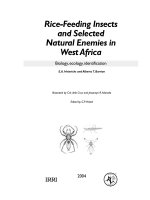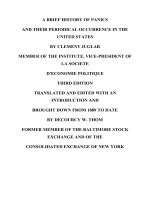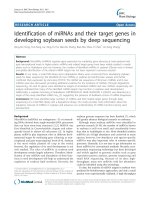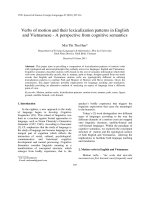Insect pests of mustard and their natural enemies in Assam
Bạn đang xem bản rút gọn của tài liệu. Xem và tải ngay bản đầy đủ của tài liệu tại đây (335.59 KB, 6 trang )
Int.J.Curr.Microbiol.App.Sci (2020) 9(7): 2785-2790
International Journal of Current Microbiology and Applied Sciences
ISSN: 2319-7706 Volume 9 Number 7 (2020)
Journal homepage:
Original Research Article
/>
Insect Pests of Mustard and their Natural Enemies in Assam
P. P. Pradhan*, R. N. Borkakati and D. K. Saikia
AICRP on Biological Control, AAU, Jorhat Centre , Department of Entomology, Assam
Agricultural University, Jorhat-785 013, India
*Corresponding author
ABSTRACT
Keywords
Mustard, Insect
pests, Natural
enemies, Predator,
Coccinellids
Article Info
Accepted:
22 June 2020
Available Online:
10 July 2020
Field experiment was conducted in Instructional-Cum-Research (ICR) farm, Assam
Agricultural University, Jorhat during rabi 2018& 2019 to investigate the insect pests and
natural enemies of mustard. During the period of present investigation, a total number of
four insect pests from four different families viz, mustard aphid, Lipaphis erysimi (Kalt.);
mustard sawfly, Athalialugens proxima (Klug); Flea beetle, Phyllotreta Cruciferae
(Goeze); cabbage butterfly, Pieris brassicae (Linn.) were recorded at different stages of
mustard crop. On the other hand, total three predators viz, coccinellid beetle (Coccinella
transversalis (Fab.) and Harmonia axyridis (Fab.), green lacewing, Chrysoperla carnea
(Stephens); syrphid fly, Xanthogrammas cutellaris (Fab.) and one aphid parasitoid,
Diaeretiella rapae (M’lntosh) were recorded as major natural enemies on insect pests of
mustard. However, out of both coccinellids C. transversalis was dominant and considered
as major predator of aphids.
Introduction
Oilseed crops play a vital role in Indian
agricultural economy. Mustard, Brassica
juncea L. is one of the first domesticated
oilseed crops amongst all the plants under
family Cruciferae. Rapeseed &mustard
(Brassica spp.) is cultivated throughout India
in spite of diverse agro-climatic conditions
ranging from north-eastern/north-western hills
to down south under irrigated/rainfed,
timely/late sown, saline soils and mixed
cropping over an area of 5.96 million hectare
with a production of 8.32 million tones and
productivity of 1397 kg/ha in 2017-18 in
India. Assam records 0.29 million hectare of
area with an annual production of 0.19
million tonnes which gives an annual yield
about 669 kg/ha (Anonymous, 2018).
Among the various factors responsible for the
low yield of mustard, damage inflicted by
various insect pests is an important factor.
Study of different insect pests are very
essential to develop future transgenic plant of
cruciferous vegetable (Shelton et al., 2009).
Rai, 1976 enlisted a total of 24 species of key
insect pests of mustard and rapeseed crop in
India which responsible for severe infestation
in different stages of crop. Further, Purwar et
al., 2004 recorded more than 43 species of
insect pests of rapeseed-mustard crop in India,
2785
Int.J.Curr.Microbiol.App.Sci (2020) 9(7): 2785-2790
out of which, the mustard aphid, Lipaphis
erysimi (Kalt), the mustard saw fly,
Athalialugens proxima (Klug), the painted
bug, Bagrada hilaris (Burmeister) and the
leaf miner, Phytomyza horticola (Goureau)
are considered as major pests of mustard.
Among these, the mustard aphid, L. erysimi
(Kalt) has been mentioned as the most
important insect pest infesting the crop right
from seedling stage to maturity causing up to
96% yield losses (Singh and Sachan, 1994;
Sharma and Kashyap, 1998; Singh and
Sharma, 2002). Mustard sawfly, A.
lugensproxima Klug has become a serious
pest of mustard and radish in several regions
of India, including the north-east India
(Narayanan and Gopalakrishnan, 2003;
Chowdhury, 2009). It is a pest of cold
weather and is generally active during
October to March. Mustard sawfly attacks the
crop at early growth period when the
seedlings are 3-4 weeks old (Bogawat, 1967;
Sehgal et al., 1975; Verma and Sachan, 1997;
Pradhan et al., 2020a). In some situations,
complete reduction in yield may be observed
due to attack of A. proximaalone but on an
average, reduction is about 25% (Sachan,
1990). However, in a blance agro ecosystem,
a number of useful biocontrol agents always
present to maintain equilibrium and out of
those a few entomopathogenic fungi are very
much effective for management of insect
pests of mustard (Pradhan et al., 2020b).
Natural enemies like Chrysoperla Spp. and
lady bird beetles, C. septempunctata appear at
the later stage of crop when most of the
damage has been caused by aphids in
mustard. Moreover, populations of these two
natural enemies are too low to reduce
numbers of aphids (Aslam and Razaq, 1989).
Materials and Methods
The present investigation was conducted to
study the diversity of insect pests of Brassica
campestris var. toria (TS-38) and their natural
enemies. A suitable and uniform site situated
at 26°45 latitude and 94°12 E longitude at an
altitude of 87m above mean sea level. An area
of 500 m2 was raised as per recommendation
of Package of Practice of Assam Agricultural
University, Jorhat except plant protection
measure for the survey and the investigation.
There were 10 subplots of 1m2size selected
randomly. Observations on incidence of
mustard aphid and its natural enemies were
recorded on 10 cm apical twig at weekly
interval by selecting 10 plants randomly from
each subplot. Further, to assess the population
of other pests including mustard sawfly and
flea beetle 10 plants were selected from each
subplot and the population of the insects were
counted visually in situ at weekly interval.
Monitoring of the incidence of insect pests
and their natural enemies was carried out
along with collection of adult arthropods
through sweep net method, and adopting the
methods suggested by Reissig et al., (1986)
and Bayot et al., (1990). Direct count method
of arthropods by visual observation was also
carried out as and when necessary. The
arthropods were sorted out under stereozoom
binocular microscope, separated, counted, and
identified up to species/genus/family level
with available keys and literature. To study
the feeding potential of adult ladybird beetles,
10 numbers of coccinelids were kept in petri
dishes containing 500 numbers of aphids and
then predatory efficiency observed after 24 hr.
Results and Discussion
During the period of present investigation, a
total number of four insect pests (Table 1.&
Fig. 1-3.) were recorded at different stages of
mustard under different orders and different
families viz, mustard aphid, L.erysimi (Kalt.);
mustard sawfly, A.lugensproxima (Klug);flea
beetle, P.Cruciferae (Goeze); cabbage
butterfly, P. brassicae (Linn.).
2786
Int.J.Curr.Microbiol.App.Sci (2020) 9(7): 2785-2790
Table.1 Insect pest complex associated with mustard
Common name
Mustard aphid
Mustard sawfly
Scientific name
Lipaphis erysimi(Kalt.)
Athalialugens proxima (Klug)
Cabbage butterfly
Flea beetle
Pieris brassicae (Linn.)
Phyllotreta cruciferae (Goeze)
Order: Family
Hemiptera: Aphididae
Hymenoptera:
Tenthredinidae
Lepidoptera: Pieridae
Coleoptera:
Chrysomelidae
Feeding site
Leaf
Leaf
Status
+++
+++
Leaf
Leaf
+++
+
+ observed 1 or 2 times/ +++ observed frequently almost all time
Table.2 List of natural enemies (predators) of insect pests of mustard
Species
Coccinella transversalis (Fab.)
Harmonia axyridis (Fab.)
Chrysoperla carnea (Stephens)
Xanthogrammascutellaris (Fab.)
Diaeretiella rapae (M’lntosh)
Order
Coleoptera
Coleoptera
Neuroptera
Diptera
Hymenoptera
Family
Coccinellidae
Coccinellidae
Chrysopidae
Syrphidae
Braconidae
Prey
L. erysimi
L. erysimi
L. erysimi
L. erysimi
L. erysimi
Prey stage
Nymph and adult
Nymph and adult
Nymph and adult
Nymph and adult
Nymph and adult
Fig.1-8 Adult of Lipaphis erysimi (1) Larva of Athalialugens proxima (2) Adult of Phyllotreta
cruciferae (3) Adult of Diaeretiella rapae(4) Larva of Coccinella transversalis (5) Adult of
Coccinella transversalis (6) Adult of Harmonia axyridis(7) Eggs of Chrysoperla carnea (8)
1
2
3
4
5
6
7
8
Among these four insect pests, mustard aphid,
mustard sawfly and cabbage butterfly were
more destructive and considered as major
insect pests of mustard whereas the flea beetle
2787
Int.J.Curr.Microbiol.App.Sci (2020) 9(7): 2785-2790
was occurred in a negligible manner and
considered as the minor pest of mustard. In
present investigation, among different insect
pests associated with mustard crop, L. erysimi
showed the highest occurrence followed by A.
lugensproxima. Moreover, the major insect
pests were observed frequently during each
observation period, but minors were observed
only one or two times. During the course of
investigation, total three predators (Table 2 &
Fig. 4-8.) viz, occinellid beetle, green
lacewing, Chrysoperla carnea (Stephens);
syrphid fly, Xanthogrammas cutellaris (Fab.)
and one aphid parasitoid, Diaeretiella rapae
(M’lntosh) were recorded as major natural
enemies on insect pests of mustard. However,
two species of coccinellid predators viz,
Coccinella transversalis (Fab.) and Harmonia
axyridis (Fab.) were observed out of which,
C. transversalis was dominant and considered
as major predator of aphids.
Several studied have shown that different
insect pests infest rapeseed-mustard at
different locations in India. Rai, 1976
reported a total of 24 insect pests from India,
whereas Bakhetia and Sekhon, 1989 recorded
38 numbers of insect pests. Manzar et al.,
1998observed that only the predatory
coccinellid Coccinella spp. had a regulatory
effect on L. erysimi. A survey made by Singh
et al., 2000 to record the coccinellid predators
associated with mustard aphid, L. erysimi
infesting mustard crop revealed that four
species of coccinellidsviz, C. septempunctata,
C. transversalius, C. sexmaculata and B.
suturalis were present. Among these, C.
septempunctata and C. transversalis were
important aphidiphagous coccinellid predators
of the mustard aphid. The predator species
such as green lace wing (C. carnea), eleven
spotted ladybird beetle (C. undecimpunctata)
and seven spotted ladybird beetle (C.
septempunctata) were recorded when the pest
population of aphids was sufficiently
developed on the rape cultivars (Talpur and
Khuhro, 2004). Kumar et al., 1988revealed
that number of syrphid species active on the
crop was influenced by the level infestation
by L. erysimi, Myzuspersicae and Brevicoryne
brassicae. Ohiman and Kumar, 1986 reported
D. rapae as an important parasitoid of L.
erysimi in India and found it plays significant
role in biological control of L. erysimi.
Kakakhel et al., 1998reportedD. rapae as an
endoparasitoid of the turnip aphid L. erysimi
with a wide geographical distribution. Raj and
Lakhanpal, 1998 studied the efficacy of D.
rapae on L. erysimi and found that the
parasitism rate was 31.69% and parasitoid
host ratio was about 1:5.6. Nevertheless, from
the study conducted by Begam et al., 2016
revealed that Coccinella transversalis and
Micraspis discolor were the most dominant
predator species observed throughout the
cropping season of BhutJalakia. Interestingly,
while the number of Coccinellids increases
leads to maximum quantity of cabbage yield,
which is also an important cruciferous
vegetable (Pradhan et al., 2020a; Borkakati et
al., 2018; Borkakati et al., 2019).
In conclusion from the present investigation it
can be concluded that the mustard aphid,
mustard sawfly, flea beetle and cabbage
butterfly were key pests of mustard found
abundantly at different developing stages of
the crop. Fortunately a number of natural
enemies of these pests also present along with
them. These beneficial biocontrol agents are
useful for pest suppression in an ecologically
viable and sustainable pest management
programmre. These biocontrol agents helps in
reduction of various problems like
environment pollution, development of pest
resistance against insecticides, pest outbreak,
pest resurgence and unacceptable higher level
of pesticide residue on the crop besides
human health risk. Moreover, due to untimely
rain and climate change may be the reason for
less encounter of insect pests and other
arthropods in the field during the time of
investigation.
2788
Int.J.Curr.Microbiol.App.Sci (2020) 9(7): 2785-2790
Acknowledgement
The authors are grateful to the Director of
NBAIR, Bangaluru for the necessary funding
for the experiment. The authors are also
indebted to the Director of Research (Agri),
Assam Agricultural University, Jorhat-785
013 for their help and suggestion during the
course of the investigation.
References
Anonymous. 2018. Agricultural Statistics at a
Glance. Ministry of Agriculture &
Farmers Welfare, Department of
Agriculture, Cooperation & Farmers
Welfare Directorate of Economics &
Statistics. pp. 110-112.
Aslam, M., Razaq, M. 2007.Arthropod fauna
of Brassica napus and Brassica juncea
from
Southern
Punjab
(Pakistan).Journal
of
Agricultural
Urban Entomology, 24: 49-50.
Bakhetia, R. C., Sekhon, B. S. 1989. Insect
pests and their management in rapeseed
mustard. Journal of Oilseed Research,
6(2): 269-299.
Begam, N., Saikia, D. K., Borkakati, R. N.
2016. Seasonal incidence of major
insect-pests and their natural enemies of
BhutJolokia. Annals of Plant Protection
Sciences, 24(2): 259-264.
Bogawat, J. K. 1967. Biology of mustard
sawfly on different host plants.Indian
Journal of Entomology,29: 270-274.
Borkakati, R.N., Saikia, D.K.,Sarma, D. 2019.
Manipulation of crop habitat to
encourage natural enemies against key
pests of cabbage ecosystem. Journal of
entomology and zoology studies,7(3):
151-54.
Borkakati, R. N., Saikia, D. K., Buragohain,
P. 2018. Natural enemy fauna of agrihorti ecosystem of Assam. Indian
Journal of Entomology, 80(3): 658-661.
Chowdhury, M. 2009. Incidence of saw fly,
Athalialugens
proxima
Klug as
influenced by level of irrigation and
fertilizers on mustard.Journal of Plant
Protection Science, 1: 80-82.
Kakakhel, S. A., Ahmed, K., Anjad, M.,
Hussain, S. A. 1998. The side effects of
pesticides on Diaeretiella rapae, a
parasitoid of the turnip aphid (Lipaphis
erysimi).Anzeiger fur Schadligskunde,
Ptlanzenschutz, Umwettschulz 71: 6163.
Kumar, A., Kapoor, V. C., Mahal, M. S.
1988. Population buildup and dispersion
of immature stages of aphid phagous
syrphids (Syrphidae: Diptera) on raya
Brassica junceaCoss. Journal of Insect
Science, 1:39-48.
Manzar, A., Lal, M. N., Singh, S. S. 1998.
Correlation between incidence of insect
pests on Brassicae species and
ecological parameters. Shashpa, 5: 171174.
Narayanan, K., Gopalakrishnan, C. 2003.
Evaluation
of
entomopathogenic
nematode, Steinernema feltiae against
field population of mustard sawfly,
Athalialugens proxima (Klug) on
radish.Indian Journal of Experimental
Biology, 41: 376-378.
Pradhan, P.P., Borkakati, R.N.,Saikia, D.K.
2020a. Bio efficacy of certain
entomopathogenic fungus against major
insect pests of Brassica campestris
var.Toria.Journal of entomology and
zoology studies,8(1): 840-843.
Pradhan, P.P., Borkakati, R. N., Saikia, D.K.
2020b. Seasonal incidence of insect
pests and natural enemies of mustard in
relation to meteorological parameters.
Journal of entomology and zoology
studies,8(1): 1538-1542.
Purwar, J. P., Singh, R. K., Mall, P. 2004.
Eco-friendly management of insect
pests in rapeseed-mustard. Indian
Farmers Digest, 37(10): 34-35.
Rai, B. K. 1976. Pests of oilseed crops in
2789
Int.J.Curr.Microbiol.App.Sci (2020) 9(7): 2785-2790
India and their control. ICAR, New
Delhi, p. 121.
Raj, D., Lakhanpal, G. C. 1998. Efficacy of
endoparasitoid, Diaeretiella rapae on
aphid complex infesting rapeseed in
mid hill zone of Himachal Pradesh.
Indian
Journal
of
Entomology
Research,22: 245-251.
Sachan, G. C. 1990. Insect pest problem in
Brassica and research work at
Pantnagar, Paper presented at second
Brassica
subnet
work
meeting
sponsored by DRC Canada held on
January 4-6, 1986 at G.B.P.U.A.T.,
Pantnagar, India.
Sehgal, V. K., Bhattacharya, A. K., Singh, K.
N. 1975. Food preference of mustard
sawfly grubs, Athalia proxima Klug.
(Hymenoptera:
Tenthredinidae).
Scientific Culture, 41(9): 430-433.
Sharma, P. K., Kashyap, N. P. 1998.
Estimation of losses in three different
oil seed Brassica crops due to aphid
complex
in
Himachal
Pradesh
(India).Journal
of
Entomological
Research, 22: 22-25.
Shelton, A. M., Gujar, G. T., Chen, M., Rauf,
A., Srinivasan, R., Kalia, V., Mittal, A.,
Kumari, A., Ramesh, K., Borkakati, R.,
Zhao, J. Z., Endersby, N., Russell, D.
A., Wu, Y. D., Uijtewaal, B.
2009.Assessing the susceptibility of
cruciferous Lepidoptera to Cry1Ba2 and
Cry1Ca4
for
future
transgenic
cruciferous
vegetables.
Journal
Economic Entomology, 102(6): 22172223.
Singh, C. P., Sachan, G. C. 1994. Assessment
of yield losses in yellow sarson due to
mustard
aphid,
Lipaphis
erysimiKalt.Journal
of
Oilseed
Research, 11(2): 179-184.
Singh, N. N., Rai, S., Rai, S. 2000. Relative
abundance of different coccinellids in
mustard ecosystems. Indian Journal of
Entomology, 62: 422-426.
Singh, Y. P., Sharma, K. C. 2002. Integrated
approach to manage the mustard aphid
Lipaphis
erysimi
(Kaltenbach)
(Homoptera: Aphididae) in oilseed
Brassica crops- a review. Journal of
Amphibiology, 16: 77-78.
Talpur, M. A., Khuhro, R. D. 2004. Relative
occurrence and abundance of mustard
aphid, Lipaphis erysimi (Kalt.) and their
predators on Rainbow and Oscar canola
varieties. Journal of Asia Pacific
Entomology,7(2): 215-219.
Verma, R. K., Sachan, G. C. 1997. Impact of
sowing time on the occurrence of
Athalia proxima Klug on three Brassica
cultivars.Annals of Plant Protection
Sciences, 5(1): 44-47.
How to cite this article:
Pradhan, P. P., R. N. Borkakati and Saikia, D. K. 2020. Insect Pests of Mustard and their
Natural Enemies in Assam. Int.J.Curr.Microbiol.App.Sci. 9(07): 2785-2790.
doi: />
2790









